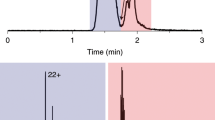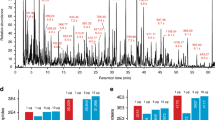Abstract
The core prerequisites for an efficient proteome-scale analysis of mammalian membrane proteins are effective isolation, solubilization, digestion and multidimensional liquid chromatography-tandem mass spectrometry (LC-MS/MS). This protocol is for analysis of the mammalian membrane proteome that relies on solubilization and tryptic digestion of membrane proteins in a buffer containing 60% (vol/vol) methanol. Tryptic digestion is followed by strong cation exchange (SCX) chromatography and reversed phase (RP) chromatography coupled online with MS/MS for protein identification. The use of a methanol-based buffer eliminates the need for reagents that interfere with chromatographic resolution and ionization of the peptides (e.g., detergents, chaotropes, inorganic salts). Sample losses are minimized because solubilization and digestion are carried out in a single tube avoiding any sample transfer or buffer exchange between these steps. This protocol is compatible with stable isotope labeling at the protein and peptide level, enabling identification and quantitation of integral membrane proteins. The entire procedure—beginning with isolated membrane fraction and finishing with MS data acquisition—takes 4–5 d.
This is a preview of subscription content, access via your institution
Access options
Subscribe to this journal
Receive 12 print issues and online access
$259.00 per year
only $21.58 per issue
Buy this article
- Purchase on Springer Link
- Instant access to full article PDF
Prices may be subject to local taxes which are calculated during checkout





Similar content being viewed by others
References
Wallin, E. & von Heijne, G. Genome-wide analysis of integral membrane proteins from eubacterial, archaean, and eukaryotic organisms. Protein Sci. 7, 1029–1038 (1998).
Hopkins, A.L. & Groom, C.R. The druggable genome. Nat. Rev. Drug Discov. 1, 727–730 (2002).
Wu, C.C. & Yates, J.R. The application of mass spectrometry to membrane proteomics. Nat. Biotechnol. 21, 262–267 (2003).
Aebersold, R. & Mann, M. Mass spectrometry-based proteomics. Nature 422, 198–207 (2003).
Santoni, V., Molloy, M. & Rabilloud, T. Membrane proteins and proteomics: un amour impossible? Electrophoresis 21, 1054–1070 (2000).
Loo, R.R., Dales, N. & Andrews, P.C. Surfactant effects on protein structure examined by electrospray ionization mass spectrometry. Protein Sci. 3, 1975–1983 (1994).
Funk, J., Li, X. & Franz, T. Threshold values for detergents in protein and peptide samples for mass spectrometry. Rapid Commun. Mass Spectrom. 19, 2986–2988 (2005).
Blonder, J. et al. A detergent- and cyanogen bromide-free method for integral membrane proteomics: application to Halobacterium purple membranes and the human epidermal membrane proteome. Proteomics 4, 31–45 (2004).
Blonder, J. et al. Analysis of murine natural killer cell microsomal proteins using two-dimensional liquid chromatography coupled to tandem electrospray ionization mass spectrometry. J. Proteome Res. 3, 862–870 (2004).
Link, A.J. et al. Direct analysis of protein complexes using mass spectrometry. Nat. Biotechnol. 17, 676–682 (1999).
Han, D.K., Eng, J., Zhou, H. & Aebersold, R. Quantitative profiling of differentiation-induced microsomal proteins using isotope-coded affinity tags and mass spectrometry. Nat. Biotechnol. 19, 946–951 (2001).
Washburn, M.P., Wolters, D. & Yates, J.R.III. Large-scale analysis of the yeast proteome by multidimensional protein identification technology. Nat. Biotechnol. 19, 242–247 (2001).
Paoletti, A.C., Zybailov, B. & Washburn, M.P. Principles and applications of multidimensional protein identification technology. Expert Rev. Proteomics 1, 275–282 (2004).
Blonder, J. et al. A proteomic characterization of the plasma membrane of human epidermis by high-throughput mass spectrometry. J. Invest. Dermatol. 123, 691–699 (2004).
Yates, J.R.III, Gilchrist, A., Howell, K.E. & Bergeron, J.J. Proteomics of organelles and large cellular structures. Nat. Rev. Mol. Cell. Biol. 6, 702–714 (2005).
Foster, L.J. et al. A mammalian organelle map by protein correlation profiling. Cell 125, 187–199 (2006).
Andersen, J.S. & Mann, M. Organellar proteomics: turning inventories into insights. EMBO Rep. 7, 874–879 (2006).
Karsan, A. et al. Proteomic analysis of lipid microdomains from lipopolysaccharide-activated human endothelial cells. J. Proteome Res. 4, 349–357 (2005).
Blonder, J. et al. Proteomic investigation of natural killer cell microsomes using gas-phase fractionation by mass spectrometry. Biochim. Biophys. Acta 1698, 87–95 (2004).
Blonder, J. et al. Quantitative profiling of the detergent-resistant membrane proteome of iota-b toxin induced vero cells. J. Proteome Res. 4, 523–531 (2005).
Blonder, J. et al. Combined chemical and enzymatic stable isotope labeling for quantitative profiling of detergent-insoluble membrane proteins isolated using Triton X-100 and Brij-96. J. Proteome Res. 5, 349–360 (2006).
Chan, K.C., Muschik, G.M. & Issaq, H.J. Solid-state UV laser-induced fluorescence detection in capillary electrophoresis. Electrophoresis 21, 2062–2066 (2000).
Schindler, J., Lewandrowski, U., Sickmann, A., Friauf, E. & Nothwang, H.G. Proteomic analysis of brain plasma membranes isolated by affinity two-phase partitioning. Mol. Cell. Proteomics 5, 390–400 (2006).
Eng, J.K., McCormack, A.L. & Yates, J.R. An approach to correlate tandem mass spectral data of peptides with amino acid sequences in a protein database. J. Am. Soc. Mass Spectrom. 5, 976–989 (1994).
Krogh, A., Larsson, B., von Heijne, G. & Sonnhammer, E.L.L. Predicting transmembrane protein topology with a hidden Markov model: application to complete genomes. J. Mol. Biol. 305, 567–580 (2001).
Moller, S., Croning, M.D. & Apweiler, R. Evaluation of methods for the prediction of membrane spanning regions. Bioinformatics 17, 646–653 (2001).
Kyte, J. & Doolittle, R.F. A simple method for displaying the hydropathic character of a protein. J. Mol. Biol. 157, 105–132 (1982).
Acknowledgements
This project has been funded in whole or in part by federal funds from the National Cancer Institute, National Institutes of Health, under Contract NO1-CO-12400. The content of this publication does not necessarily reflect the views or policies of the Department of Health and Human Services, nor does mention of trade names, commercial products or organizations imply endorsement by the United States government.
Author information
Authors and Affiliations
Corresponding author
Ethics declarations
Competing interests
The authors declare no competing financial interests.
Rights and permissions
About this article
Cite this article
Blonder, J., Chan, K., Issaq, H. et al. Identification of membrane proteins from mammalian cell/tissue using methanol-facilitated solubilization and tryptic digestion coupled with 2D-LC-MS/MS. Nat Protoc 1, 2784–2790 (2006). https://doi.org/10.1038/nprot.2006.359
Published:
Issue Date:
DOI: https://doi.org/10.1038/nprot.2006.359
This article is cited by
-
Inhibition of bacterial swimming by heparin binding of flagellin FliC from Escherichia coli strain Nissle 1917
Archives of Microbiology (2023)
-
Protein A of Staphylococcus aureus strain NCTC8325 interacted with heparin
Archives of Microbiology (2021)
-
Analysis of the immune response of human dendritic cells to Mycobacterium tuberculosis by quantitative proteomics
Proteome Science (2016)
-
Alteration of protein prenylation promotes spermatogonial differentiation and exhausts spermatogonial stem cells in newborn mice
Scientific Reports (2016)
-
Quantitative proteomic analysis of thylakoid from two microalgae (Haematococcus pluvialis and Dunaliella salina) reveals two different high light-responsive strategies
Scientific Reports (2014)
Comments
By submitting a comment you agree to abide by our Terms and Community Guidelines. If you find something abusive or that does not comply with our terms or guidelines please flag it as inappropriate.



